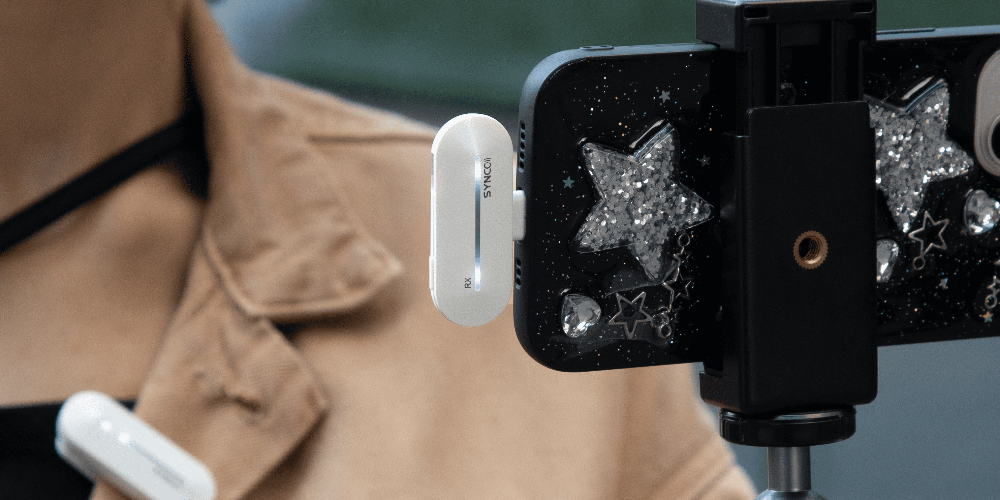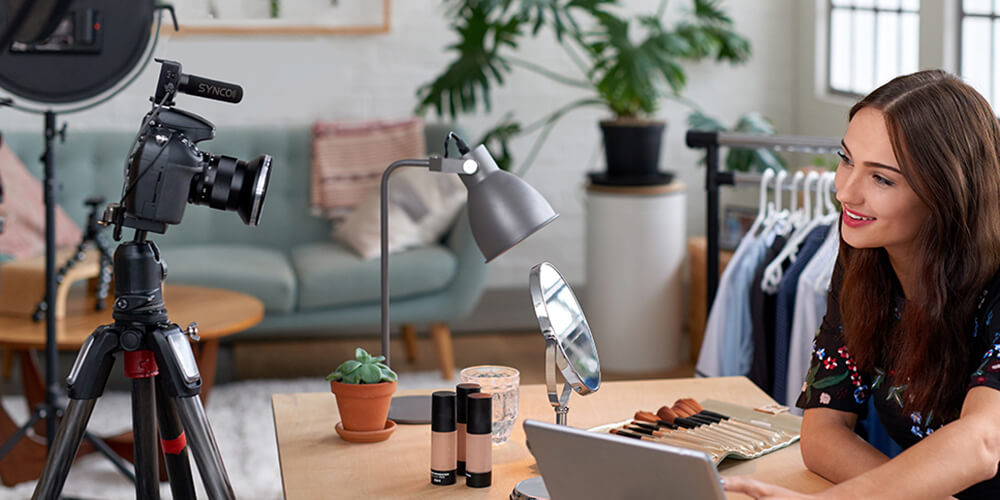If you are an interviewer or podcaster, you must have a wireless interview microphone that can help you get the best audio. But the trouble starts when you intend to purchase one without any expertise. Before placing an order for a product, there are a lot more features to take into account. This buyer guide will recommend the best ones for you and tell you how to select.
- Best wireless interview microphone recommended at Moman PhotoGears
- Which kind of wireless mic for interview should you buy, Lavalier, shotgun, or handheld?
- Five things to think about before choosing an ideal wireless interview mic
- How to get better audio when recording with a wireless microphone for street interviews?

Best wireless interview microphone recommended at Moman PhotoGears
Here we list five ideal options for you, including the shotgun type SYNCO D30 and U3, and the wireless Lavalier type Moman CP2, SYNCO P2L, and G2(A2) Max.
SYNCO D30 professional wireless shotgun interview microphone
- Price: US$129.00
SYNCO D30 is a wireless interview microphone for DSLR of shotgun type. It is also compatible with BMPCC, mirrorless, and other kind of cameras. Due to its simplicity of use and wide compatibility with camera audio jacks, it is used by most professional journalists. It can capture natural sound recording thanks to its high sensitivity. Furthermore, the supercardioid polar pattern's strong directionality excludes undesired sounds and concentrates on precisely collecting the intended sound source.
SYNCO U3 best boom mic for interviews
- Price: US$79.00
The SYNCO U3 is yet another excellent wireless mic for a walking interview. The single-tube body of this sports a classic shotgun mic design and may be fixed to boom poles, mic stands, or cameras. It is more portable and cheaper than the SYNCO D30, being ideal for new interviewers.
Moman CP2 budget wireless clip-on interview mic for smartphone
- Price: US$65.99 for Type-C plug, US$69.99 for lightning plug
Moman CP2 is vocally stable due to its practical compact design and excellent portability. This wireless Lav interview mic can be used with Android phones with Type-C interface, or iPhones with Lightning ports. Because of its excellent speech intelligibility and mini-jack with body-pack transmitters that improve the mic's audio delivery, it has an unrivaled clean voice delivery.
SYNCO P2L wireless interview microphone for iPhone
- Price: US$59.00
With iPhone, iPad, or recording devices that have lightning ports, the SYNCO P2L lets you shoot videos in high definition with crystal-clear audio. It may be utilized with portable audio recorders as well. Because of its dual-channel transmitters, great sensitivity, and wide frequency range, you will get authentic audio reproduction during outdoor interviews.
SYNCO G2(A2) Max best wireless Lavalier mic for interviews
- Price: US$169.00
The lightweight Lavalier interview microphone SYNCO G2(A2) Max uses wireless technology to record audio in the greatest quality. It is user-friendly with one receiver and two transmitters for two-person recording or live streaming. It is designed to have effective noise-cancellation and 8G onboard memory for continuous interviewing.

Which kind of wireless mic for interview should you buy, Lavalier, shotgun, or handheld?
We list the advantages and drawbacks of three popular types of wireless microphones for interviewing, including the clip-on Lavalier, on-camera shotgun, and handheld mics. You can make your decision after getting to know them well.
Lavalier wireless microphone for interviews
A wireless Lavalier interview mic is a tiny microphone that is worn on the source's skin or clothes.
Pros: It's perfect for recording personal and constant audio from a single subject, such as an actor, narrator, or presenter. It is appropriate for dynamic scenarios as it lets the source move freely without degrading the sound quality. It is portable, and small to hide, and some of them support hundreds of meters of recording thanks to wireless technology.
Cons: This type of wireless interview camera microphone also faces some difficulties. If you don't cover it up with clothing, it may be noticeable and annoying. It can also pick up undesired sounds from the backdrop, your skin, or your clothing, therefore you might require noise reduction software or a windshield. Also, if it is positioned too near or too far from the lips, the voice may sound distorted or muffled.
Shotgun wireless mic mounted on the camera or phone for interviewing
A directional mic that captures sound from a small region in front of it is called a shotgun microphone.
Pros: This wireless on-camera interview microphone is perfect for recording distinct and well-focused audio from a single source, such as a sound effect, speaker, or interviewee. Additionally, it blocks out unwanted noise from the rear and the sides, making it appropriate for loud settings.
Cons: It does have several shortcomings. It may need a camera mount or a boom pole because it might be hefty and cumbersome. It may require a glass or a shock mount because it can also pick up undesired sounds from the front, including wind, traffic, or reflections. Furthermore, if the source moves out of the microphone's range or is too far away, it may sound artificial or distant.
Wireless handheld interview microphone
Pros: In several situations, such as live performances and studio recordings, handheld microphones are indispensable. Because of their design, which gives them direct control over the sound recording, artists frequently take advantage of the proximity effect of the mic to alter the presence and depth of their voices. Compared to the collar clip mic, this type produces a louder sound. Thus, the interviewer may adjust the volume and tone to add more emphasis by adjusting the distance from the speaker.
Cons: Unfortunately, due to the handheld's inclination to reject and minimize sounds that are not in its optimal pickup cone, they are extremely invasive in the shot and need to be directed at the person speaking to capture decent sound. However, for this reason, it is effective in rejecting external noise.

Four things to think about before choosing an ideal wireless interview mic
Before choosing the finest wireless interview mic for your smooth recording, here are a few things you should consider.
Budget: How much do you prepare for buying a wireless video interview microphone?
Prices may vary for an interview with a wireless microphone. Compared to entry-level wireless microphones, professional microphones are often more costly. As such, you need to be aware of why you are purchasing a microphone as well as how much you are prepared to pay.
Polar pattern: How does the wireless mic pick up sounds during the interview?
Polar pattern refers to the tracks of how the best wireless interview microphone captures the sound. There are four kinds: Omnidirectional, bidirectional, cardioid, and super-cardioid. The omnidirectional wireless mics are widely recommended by professionals for one-on-one interviews since they evenly capture sound from all directions. Cardioid types are an ideal option for street interviews since they capture sounds from the mic's pointing portion and ignore the background noise.
Transmission range: How far away can the interviewee be from the wireless mic and camera lens?
When selecting the finest wireless microphone for an interview, the range is one of the most crucial considerations. And you should use the best wireless microphone for interviewing that can cover at least 100 meters. Most of the wireless clip-on mics for interview for sale at Moman PhotoGears Store feature a long transmission range and the 2.4GHz frequency range for stable and continuous recording.
Applications: In what recording environment did your interview take place?
It is important to keep in mind the setting in which you will be recording sounds. You should consider whether you will be conducting interviews in an open-air setting or a soundproof studio. Knowing this will help you choose the right kind of microphone.

How to get better audio when recording with a wireless microphone for street interviews?
For interviews and testimonies to be interesting and trustworthy, audio quality is essential. Here are some tips to have crisp, consistent audio that goes with your interview images.
Utilize a pop filter or windshield for your wireless interview microphone
A useful tip to lessen unwanted noise from wind, breath, or plosives is to use a pop filter or windshield. If you're recording outside or in a windy environment, wind noise might distort your audio. You may shield your microphone from the wind and cover it with a fuzzy or foam windscreen.
The air pressure from the subject's mouth during specific sounds, such as P, B, or T, causes breath noise and plosives. To disperse the air and stop pops and clicks, place a pop filter—a mesh or cloth screen—between the subject's lips and the best wireless Lavalier microphone for interviews videos.
Set up a proper audio level for the recording devices
To make sure the sound is loud enough without being distorted, the audio levels must be adjusted next. Your camera, recorder, or mixer's meters may be used to keep an eye on the input and output levels.
The best range for most digital devices is between -12 and -6 dB, therefore you should ideally keep the settings there. To hear the music and listen for any hum, hiss, or background noise, you need also to utilize headphones. You can try adjusting the gain, the location of the wireless interview microphone, or the device's settings if you have any issues.
Record extra audio as a backup for a better post-audio clip
Recording some room tones and other audio for future editing and mixing is the last stage. The background noise in the area you're recording, such as birds, cars, or air conditioning, is called room tone. Record a minimum of one minute of room tone either before or following the interview, with the same wireless interview mic and configurations. The room tone may be used to smooth out any cuts or transitions, as well as to fill in any silences or gaps in your audio recording. Any additional sound, such as music, sound effects, or narration, that you might need to improve your interview is referred to as extra audio.






